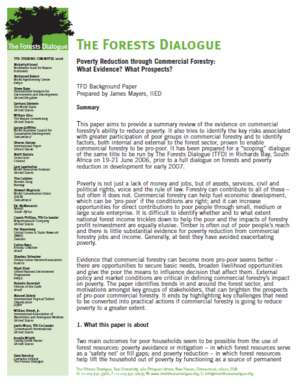Poverty Reduction through Commercial Forestry: What Evidence? What Prospects?
This paper aims to provide a summary review of the evidence on commercial forestry’s ability to reduce poverty. It also tries to identify the key risks associated with greater participation of poor groups in commercial forestry and to identify factors, both internal and external to the forest sector, proven to enable commercial forestry to be pro-poor. It has been prepared for a “scoping” dialogue of the same title to be run by The Forests Dialogue (TFD) in Richards Bay, South Africa on 19-21 June 2006, prior to a full dialogue on forests and poverty reduction in development for early 2007.
Poverty is not just a lack of money and jobs, but of assets, services, civil and political rights, voice and the rule of law. Forestry can contribute to all of these – but often it does not. Commercial forestry can help fuel economic development, which can be ‘pro-poor’ if the conditions are right; and it can increase opportunities for direct contributions to poor people through small, medium or large scale enterprise. It is difficult to identify whether and to what extent national forest income trickles down to help the poor and the impacts of forestry profit reinvestment are equally elusive. Timber is often out of poor people’s reach and there is little substantial evidence for poverty reduction from commercial forestry jobs and income. Generally, at best they have avoided exacerbating poverty.
Evidence that commercial forestry can become more pro-poor seems better – there are opportunities to secure basic needs, broaden livelihood opportunities and give the poor the means to influence decision that affect them. External policy and market conditions are critical in defining commercial forestry’s impact on poverty. The paper identifies trends in and around the forest sector, and motivations amongst key groups of stakeholders, that can brighten the prospects of pro-poor commercial forestry. It ends by highlighting key challenges that need to be converted into practical actions if commercial forestry is going to reduce poverty to a greater extent.

